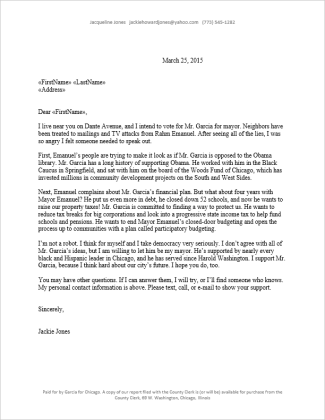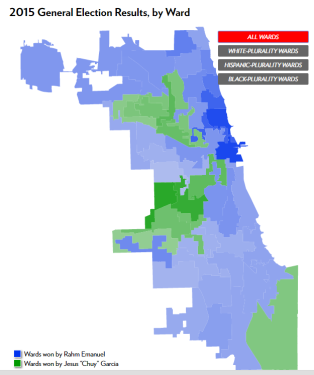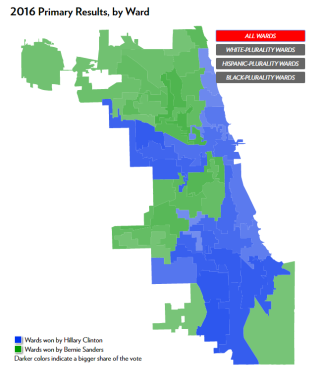It really would have been nice to see a progressive populist win here. It’s possible to do. Last year’s race between Jesus “Chuy” Garcia and Rahm “Sharp Elbows” Emanuel – the first runoff in Chicago mayoral election history – was as close as any progressive citywide candidate has ever come to upsetting established power here. Emanuel was downright “humbled” by the experience. Rahm will probably not survive to serve another term – he has been weakened by anger from the left, and now the stage is set for a right-centrist (i.e., a Chicago Democrat) to sweep in and defeat him. Rahm has no mysterious aura about him like the Daleys.
My 15-year-old son and I campaigned hard in South Side black wards for Garcia, walking the precincts door to door for two months, often in bitter cold winds. From such a vantage point, you can see what is being distributed door to door, and you can hear exactly how people feel, you learn what the arguments are, and you learn how to answer them. Both of the campaigns knew the black vote was crucial. Rahm won primarily by lying to black voters in Chicago. His well-paid media experts and strategists exploited the historical division between African-American and Hispanic political blocs in Chicago.
Rahm’s geniuses hit upon the idea that, since Chuy was opposed to the University of Chicago’s bid to site the Obama Library on Chicago’s scarce public parkland, they could claim that Chuy didn’t want the library anywhere in Chicago, and that therefore Chuy didn’t like black people. These constituted a huge distortion, this pair of lies: Chuy has been a leader on the right side of black issues in Chicago for 25 years, and he has never deviated. Still, they printed the exact opposite on millions of pieces of literature that they scattered on the South and West Sides, and they stated the same thing in TV commercials. The strategy worked. We had people slamming doors in our face. The lies moved black voters the few percent needed to ensure victory.
Hilary Clinton’s Chicago people (some of the same people, in fact) appear simply to have taken the 2015 mayoral election playbook and rerun it. It’s a popular concern when black candidates for major offices are so few. The idea was to characterize centrist Hilary as the choice for black voters, rather than the true progressive. Clinton’s geniuses included all of the right ingredients in their expensive commercials: Black-and-white photos, slow-panning, suggesting Civil Rights history. The stentorian Southern accent of the narrator. The long, low double-bowed string bass indicating the timeless struggles of history. Noble black faces aplenty. The full recipe.
“I have moved precincts to 75% wins, sometimes even higher, partly with the help of carefully crafted, targeted, methodically placed media like this.”
Clinton took Chicago by only around 30,000 votes – and she won the whole state of Illinois by less than 40,000 votes.
This map shows that Hilary had strong margins in the same Black South and West Side battleground wards that were of interest in the Emanuel-Garcia race a few months before. And so, again, Chicago’s African-American vote proved highly volatile, a force that could easily move centrist or progressive depending on how deceptive the messaging could be. Some feel that Bernie lost the black vote with a faux pas during the Flint debate, when he appeared to associate being black too closely with being poor. But with nearly one in three African-Americans below the poverty line, there were enough poor voters in Chicago’s black precincts, at least, to “feel the Bern.” And yet Hilary’s money beat Bernie’s in that market, giving the impression that she is the Civil Rights candidate, that she is the progressive – a claim that is impossible to support.
Reasoning will not fit easily in a 30-second blurb. Distortion will.

I hate to say that I anticipated this potential problem in the Sanders strategy, and although I was tempted to try to persuade them how to solve it, I didn’t do it. I thought they would know this, because it was as plain as the nose on your face, and I assumed they knew what they were doing. However, they failed. Illinois, it has been argued, spelled the beginning or the end of Sanders as a serious threat to Clinton. And so this was an important loss.
I also didn’t contact the Sanders campaign because big campaigns have little imagination, as I learned with the Garcia group. During that 2015 election cycle, I was also teaching the CivicLab training course on basic campaign operations for the aldermanic candidates. One of my favorite cheap guerrilla media tools is the plain-vanilla neighbor-to-neighbor merge letter. It is not just a mass-printed letter. I described it to the candidates: One or two days before the election, amid all of the four-color-printed trash littering the vestibules, a very personal letter will be found by every undecided voter, taped carefully to their front door. The letter is neatly typed on plain white paper, signed by hand, sealed in a handwritten envelope.
Neighbor-to-Neighbor Letter – GENERIC – 03-25-2015
In the letter, in three or four paragraphs, a neighbor identifies herself, tells you she lives right around the corner, expresses anger about the lies, answers the lies, and calls on decent and intelligent voters to ignore the innuendo and vote the right way on Tuesday. She signs the letter, in actual color ink. She circulates only a few dozen of these letters. It is that simple. I have moved precincts to 75% wins, and even higher, partly with the help of carefully crafted, targeted, methodical media like this.
Reasoning will not fit in a 30-second blurb, but people still trust letters from neighbors sooner than any anonymous four-color mailer.
When I was told how the polling in black areas was leaning for Emanuel, and when I saw the nasty lies being circulated, I knew that the letter was one way to score. But the campaign had relied primarily on union management. Union organizers are brilliant at persuasion, but they know union halls and phone banks, not sidewalks and doorbells. With two weeks to spare, I sent an e-mail to Garcia’s campaign leaders, Andrew Sharp and Clem Balanoff. I explained that a door-to-door approach was needed for the campaign. I’d already told Clem earlier that we should bus all of the best campaigners into the South and West Sides to knock on doors there. We had enough people, but they were working in neighborhoods that were already convinced.
I explained that we should distribute 24,000 letters to households in our 15 battleground wards on the South and West Sides, very close to the election. I included a sample letter and precinct data. I described how to extract the target data from the database, how to merge and print it, and how to identify and solicit volunteers and others to sponsor, approve, sign, seal, and deliver the letters. I said that with two or three coordinators, one fast laser printer, and a lot of paper and envelopes and tape, I could have the entire project started and finished in four or five days. I said that this could be done with $600 in paper, printing, and envelopes. I gave them this proposal two weeks before the election.
They didn’t even respond. Knowing how busy they were, I gave them plenty of time, but at the last possible minute I called, exasperated. Clem explained that he had dealt with the battleground wards by paying 120 workers to do literature drops there. That was all.
In fact, it seemed as if they were afraid even to ask our volunteers to go out and brave the cold. Volunteers were glad to come in for an hour or two and do phone-banking, but nobody was pressing them hard to get out on the street. If you create a culture of willingness to get out there and knock on doors, everyone will do it. If you create a culture of hanging out in the campaign office and sitting at a phone, everyone will do that. I’m not saying they weren’t working hard, but strangers persuading strangers is much more difficult over the phone.
When Andrew and Clem passed on the letter idea, I decided to test it in one precinct anyway. I picked a representative precinct where we had a willing volunteer, and she signed 120 letters to go to all of the undecided voters in her precinct. My son and I taped them to doors the day before the election.
Excel File – Post-Runoff Analysis – Neighbor Letter – Ward 8 Precinct 52 04-08-2015
After the election, I studied the numbers. The first election and the runoff results had very consistent correlations from precinct to precinct in the best and worst few precincts of both campaigns. Judging from results from the first election, our test precinct should have been Garcia’s 13th-best precinct of all in the runoff. However, it turned out to be the 8th-best in the runoff. All other precincts stayed amazingly consistent from the previous election. The only thing that was different was our letter.
That may not sound significant. But I calculated that the letter appears to have moved one in four voters in our test precinct. Done throughout the 12 battleground wards, as would have been my plan, this should have closed the margin enough for Garcia to have come very close to winning. Along with some more aggressive door-to-door persuasion in the same area, it would have been hard to lose.
The results of the Emanuel-Garcia election on the South and West Sides look eerily like those seen in the Clinton-Sanders race in many ways. The most important aspect, to me, is that both teams had Chicago in their hands if they wanted it, but instead of asking volunteers to head outside of their neighborhoods and brave the cold, instead of trying to reach voters more intimately, they thought they could beat the establishment with its own techniques – robocalls, phonebanking, color direct mail, TV commercials, radio spots. Bernie Sanders could conceivably have won Illinois from Hilary Clinton with more door-to-door campaigning in the right places. He also could have changed history with a laser printer and less than $1,000 in printing.
It is hard to win a grassroots campaign. It takes more effort, and it won’t be done without the intimacy that comes from people coming in contact with people. Getting on the streets, or at least getting something into people’s hands that looks a little different, looks like it came from a human being, can make a huge impact. These are media befitting grassroots politics. I hope that the next time an opportunity like this rolls around, someone will surprise us for a change and try the obvious.
Peter has participated in progressive politics since he was eight years old, starting with Dawn Clark Netsch’s first campaign. In 2003, he wrote the book It Happened Four Years Ago, a documentary exposé of a stolen election, a popular text in political science classes here. He has trained Chicago candidates and election volunteers for many years for the League of Women Voters, Project LEAP, CivicLab, and other organizations. He was a co-founder of Design for Democracy. He also sued the Chicago Board of Elections twice in Federal Court, after twice exposing major data vulnerabilities. But politics is a sideline, a necessary evil, and he does not enjoy it.


